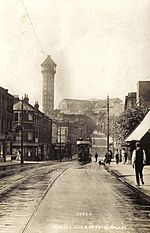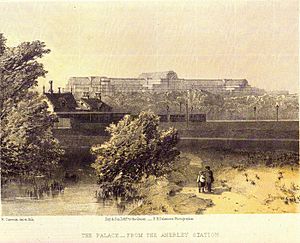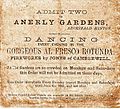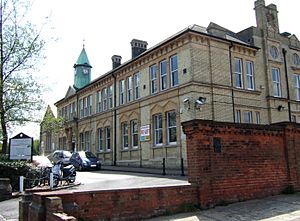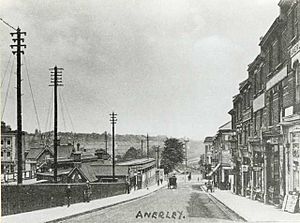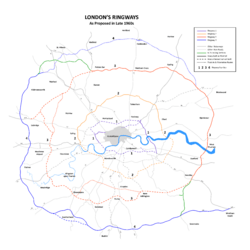Anerley facts for kids
Quick facts for kids Anerley |
|
|---|---|
| Town | |
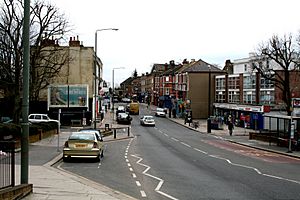 Anerley Road 2010 |
|
| OS grid reference | TQ345695 |
| • Charing Cross | 7.0 mi (11.3 km) NNW |
| London borough | |
| Ceremonial county | Greater London |
| Region | |
| Country | England |
| Sovereign state | United Kingdom |
| Post town | LONDON |
| Postcode district | SE20 |
| Dialling code | 020 |
| Police | Metropolitan |
| Fire | London |
| Ambulance | London |
| EU Parliament | London |
| UK Parliament |
|
| London Assembly |
|
Anerley is an area in south east London, England. It is part of the London Borough of Bromley. Anerley is about 7 miles (11 km) south-east of Charing Cross. It is located near Crystal Palace, Upper Norwood, Penge, Elmers End, and South Norwood.
Contents
A Look Back at Anerley's History
How Anerley Began
Anerley was not always a separate town. Before 1827, it was an empty part of Penge Common. This area started to grow in the 1800s. In 1827, a new road was built from Elmers End Road to Church Road.
That same year, a Scottish silk maker named William Sanderson bought land here. He built the first house and called it "Anerly Lodge." "Anerly" is a Scottish word meaning "solitary" or "only." The road then became known as Anerley Road, giving the whole area its name.
Canals and Railways Arrive
The Croydon Canal opened in 1809 and passed through Anerley. However, the canal did not make much money. It closed after only 27 years. The land was then sold to the London and Croydon Railway Company.
This company used most of the old canal path for a new railway line. You can still see parts of the canal today in Betts Park in Anerley. Anerley railway station opened in 1839. William Sanderson helped make this happen by providing land.
In 1845, a special type of railway called an atmospheric railway was built here. It used air pressure to move trains. This railway did not last long. On October 5, 1844, a train crash happened at Anerley. Twenty-four people were hurt, but no one died.
Fun at Anerley Gardens
Anerley Gardens opened in 1841. It was a popular place for fun and entertainment. People could easily visit by train, as it had its own station. The gardens offered dances, a boating lake, a Swiss cottage, and a maze.
The old Croydon Canal was also a favorite spot for fishing. The gardens closed in 1868. This was because the nearby Crystal Palace offered even more attractions. After the gardens closed, The Anerley Arms hotel was rebuilt. This building still stands next to the station today.
Anerley in Later Years
From the 1860s, more homes were built in Anerley. Large Victorian houses appeared along Anerley Road. Anerley Vestry Hall, now known as Anerley Town Hall, was built in 1878. It was used for public meetings and local government.
By the early 1900s, Anerley's busiest time was over. Many large Victorian houses were turned into smaller flats. New housing estates were built in the middle of the century. In 1965, Anerley became part of the London Borough of Bromley.
Anerley During World War II
During World War II, Anerley was hit by bombs. Five V1 rockets, which were flying bombs, landed in the area. More rockets also landed nearby in Crystal Palace Park.
On June 18, 1944, a V1 rocket was shot down over Anerley Park. Two people died, and many houses were damaged or destroyed. On July 11, 1944, another V1 rocket hit Anerley Road near the railway station. Eleven people died, and many shops and houses were destroyed. The Paxton Arms pub was also damaged. The last rocket hit Anerley on August 24, 1944.
Getting Around Anerley
Buses
Anerley has many London buses routes. These include routes N3, 75, 157, 197, 249, 354, 358, 432, and 356. The 432 and 249 buses now end their journeys at the Anerley Bus stand. This stand is located behind the railway station.
Roads
Two main roads, the A213 and A214, go through Anerley. In the 1960s and 1970s, the A214 was planned to be part of a big road project called the London Ringways. This project aimed to build new motorways around London.
If Ringway 2 had been built, it would have gone through much of Anerley. It would have followed the railway line. This would have meant destroying many homes and causing a lot more noise. However, after much discussion, the London Ringway projects were cancelled.
Trains
- Anerley railway station: This station offers London Overground services. You can travel from Highbury and Islington station to West Croydon.
- Birkbeck station: This station has Southern trains. They run from London Bridge to Beckenham.
Trams
- Birkbeck station: Transport for London (TFL) operates trams from Birkbeck. You can go to Beckenham Junction and Croydon.
In the past, trams ran down Anerley Road. They connected to the main tram network at West Croydon. For a while, a special engine was needed to pull trams up the steepest part of Anerley Hill. Later, trams could climb it on their own. These trams were replaced by trolley buses in 1959.
There were plans to extend the Tramlink services to Crystal Palace Parade. This would have gone through Anerley Road. However, the Mayor of London decided to cancel this project in 2008.
Notable People from Anerley
- Ira Aldridge: A famous African-American actor who performed Shakespeare plays. He lived at 5 Hamlet Road.
- Arthur Bigsworth: An aviator born in Anerley in 1885. Some say he inspired the famous fictional pilot, Biggles.
- James Busby: He helped write the Treaty of Waitangi and brought grapevines to Australia. He died in Anerley.
- Thomas Crapper: A well-known plumber. He lived at 12 Thornsett Road after he retired.
- George Daniels: A very skilled watchmaker. He lived at 21 Thornsett Road.
- Benjamin Waterhouse Hawkins: An artist who designed the famous Crystal Palace dinosaurs. He lived at 22 Belvedere Road.
- Walter de la Mare: A famous poet and writer of ghost stories. He lived at 14 Thornsett Road from 1912 to 1925.
- Dadabhai Naoroji: Known as the 'grand old man of India'. He was an Indian nationalist and a Member of Parliament. He lived at 72 Anerley Park.
- Francis Godolphin Osbourne Stuart: A photographer and postcard publisher. He lived in Hamlet Terrace in the 1870s.
Nearest Places



